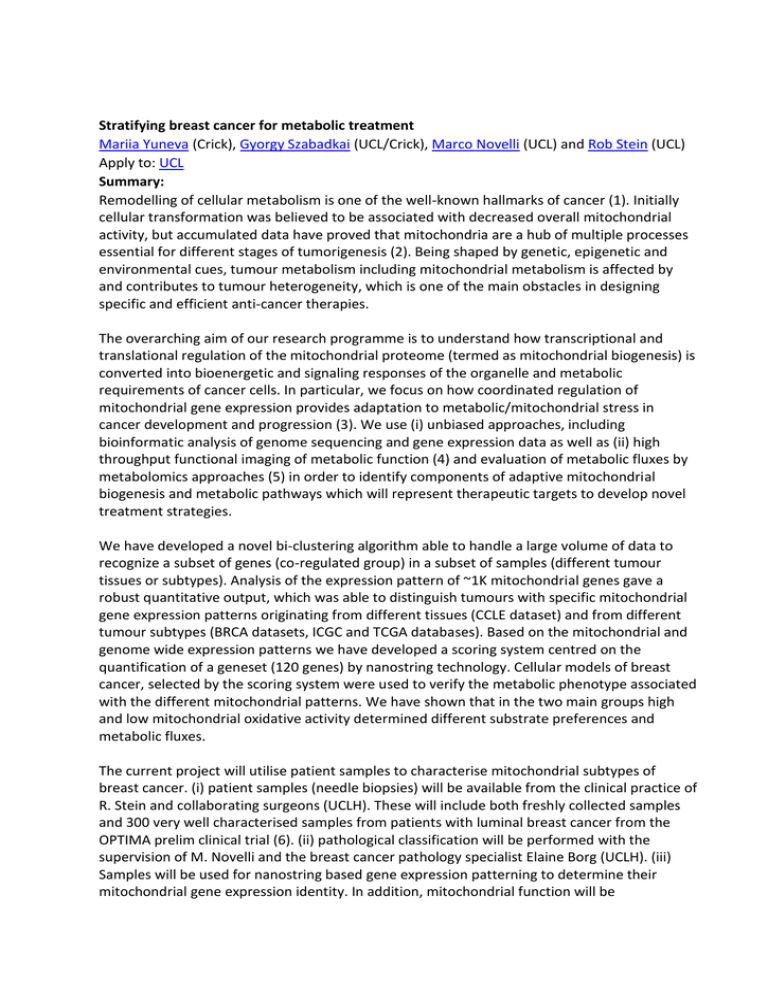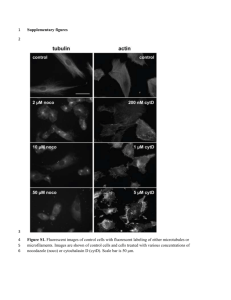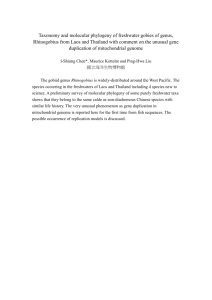Remodelling of cellular metabolism is one of the well-known hallmarks... cellular transformation was believed to be associated with decreased overall... Stratifying breast cancer for metabolic treatment
advertisement

Stratifying breast cancer for metabolic treatment Mariia Yuneva (Crick), Gyorgy Szabadkai (UCL/Crick), Marco Novelli (UCL) and Rob Stein (UCL) Apply to: UCL Summary: Remodelling of cellular metabolism is one of the well-known hallmarks of cancer (1). Initially cellular transformation was believed to be associated with decreased overall mitochondrial activity, but accumulated data have proved that mitochondria are a hub of multiple processes essential for different stages of tumorigenesis (2). Being shaped by genetic, epigenetic and environmental cues, tumour metabolism including mitochondrial metabolism is affected by and contributes to tumour heterogeneity, which is one of the main obstacles in designing specific and efficient anti-cancer therapies. The overarching aim of our research programme is to understand how transcriptional and translational regulation of the mitochondrial proteome (termed as mitochondrial biogenesis) is converted into bioenergetic and signaling responses of the organelle and metabolic requirements of cancer cells. In particular, we focus on how coordinated regulation of mitochondrial gene expression provides adaptation to metabolic/mitochondrial stress in cancer development and progression (3). We use (i) unbiased approaches, including bioinformatic analysis of genome sequencing and gene expression data as well as (ii) high throughput functional imaging of metabolic function (4) and evaluation of metabolic fluxes by metabolomics approaches (5) in order to identify components of adaptive mitochondrial biogenesis and metabolic pathways which will represent therapeutic targets to develop novel treatment strategies. We have developed a novel bi-clustering algorithm able to handle a large volume of data to recognize a subset of genes (co-regulated group) in a subset of samples (different tumour tissues or subtypes). Analysis of the expression pattern of ~1K mitochondrial genes gave a robust quantitative output, which was able to distinguish tumours with specific mitochondrial gene expression patterns originating from different tissues (CCLE dataset) and from different tumour subtypes (BRCA datasets, ICGC and TCGA databases). Based on the mitochondrial and genome wide expression patterns we have developed a scoring system centred on the quantification of a geneset (120 genes) by nanostring technology. Cellular models of breast cancer, selected by the scoring system were used to verify the metabolic phenotype associated with the different mitochondrial patterns. We have shown that in the two main groups high and low mitochondrial oxidative activity determined different substrate preferences and metabolic fluxes. The current project will utilise patient samples to characterise mitochondrial subtypes of breast cancer. (i) patient samples (needle biopsies) will be available from the clinical practice of R. Stein and collaborating surgeons (UCLH). These will include both freshly collected samples and 300 very well characterised samples from patients with luminal breast cancer from the OPTIMA prelim clinical trial (6). (ii) pathological classification will be performed with the supervision of M. Novelli and the breast cancer pathology specialist Elaine Borg (UCLH). (iii) Samples will be used for nanostring based gene expression patterning to determine their mitochondrial gene expression identity. In addition, mitochondrial function will be characterised by live cell imaging approaches supervised by G. Szabadkai’s group (UCL-Crick). (iv) Metabolite concentrations and metabolic fluxes in primary samples and cells originating from the samples will be determined by metabolomics approaches in M. Yuneva’s group (Crick). We expect that we will stratify breast cancers using their mitochondrial status and clarify their relationship to existing classifications. The project will help the student to develop basic skills in translational research and provide preliminary data for Clinical Research Training Fellowship application. References: 1. Hanahan D., and Weinberg R.A. 2011. Hallmarks of cancer: the next generation. Cell, 144, 646-674. 2. Gasparre G, Porcelli AM, Lenaz G, Romeo G. 2013. Relevance of mitochondrial genetics and metabolism in cancer development. Cold Spring Harb Perspect Biol. 5(2). 3. Yao Z, Jones a WE, Fassone E, Sweeney MG, Lebiedzinska M, Suski JM, Wieckowski MR, Tajeddine N, Hargreaves IP, Yasukawa T, Tufo G, Brenner C, Kroemer G, Rahman S, Szabadkai G. 2013. PGC-1β mediates adaptive chemoresistance associated with mitochondrial DNA mutations. Oncogene, 32:2592–600. 4. Blacker TS, Mann ZF, Gale JE, Ziegler M, Bain AJ, Szabadkai G*, Duchen MR* 2014. Separating NADH and NADPH fluorescence in live cells and tissues using FLIM. Nat Commun, 5:3936. 5. Yuneva MO, Fan TW, Allen TD, Higashi RM, Ferraris DV, Tsukamoto T, Matés JM, Alonso FJ, Wang C, Seo Y, Chen X, Bishop JM. 2012 The metabolic profile of tumors depends on both the responsible genetic lesion and tissue type. Cell Metab. 15(2):157-70. 6. Stein, RC, Dunn, JA, Bartlett, JM, Campbell, AF, Marshall, A, Hall, P, Rooshenas, L, Morgan, A, Poole, C, Pinder, SE, Cameron, DA, Stallard, N, Donovan, JL, Mccabe, C, Hughes-Davies, L & Makris, A. 2016. OPTIMA prelim: a randomised feasibility study of personalised care in the treatment of women with early breast cancer. Health Technol Assess; 20(10): 1-202.







